engine Hyundai Matrix 2004 Owner's Guide
[x] Cancel search | Manufacturer: HYUNDAI, Model Year: 2004, Model line: Matrix, Model: Hyundai Matrix 2004Pages: 317, PDF Size: 5.12 MB
Page 59 of 317
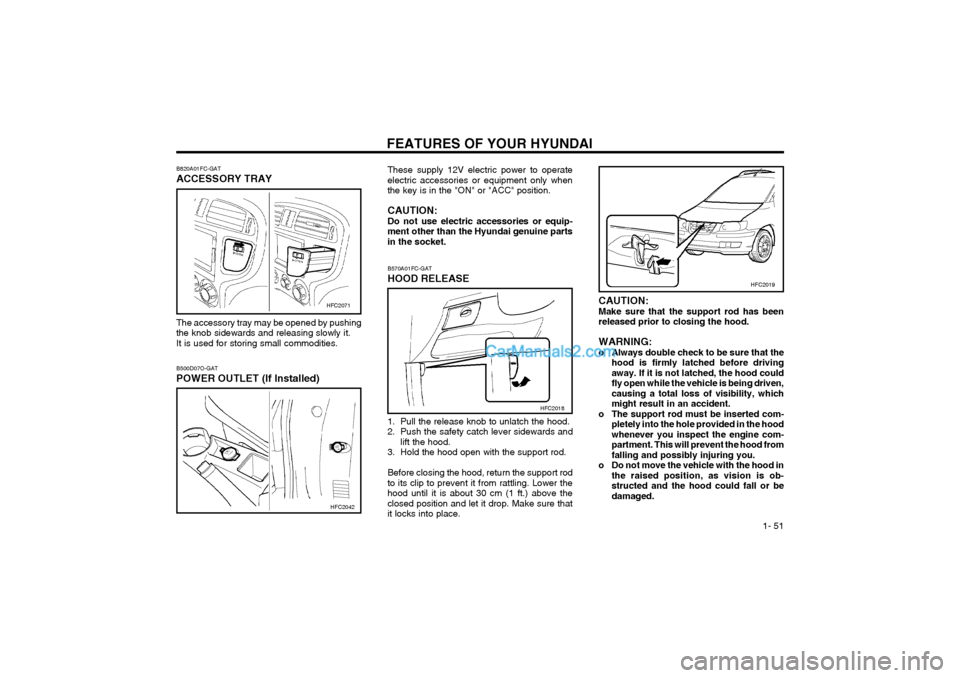
FEATURES OF YOUR HYUNDAI 1- 51
HFC2019
CAUTION: Make sure that the support rod has beenreleased prior to closing the hood. WARNING:
o Always double check to be sure that the hood is firmly latched before drivingaway. If it is not latched, the hood couldfly open while the vehicle is being driven,causing a total loss of visibility, whichmight result in an accident.
o The support rod must be inserted com- pletely into the hole provided in the hoodwhenever you inspect the engine com-partment. This will prevent the hood fromfalling and possibly injuring you.
o Do not move the vehicle with the hood in the raised position, as vision is ob-structed and the hood could fall or bedamaged.
B570A01FC-GAT HOOD RELEASE
HFC2018
1. Pull the release knob to unlatch the hood.
2. Push the safety catch lever sidewards and lift the hood.
3. Hold the hood open with the support rod. Before closing the hood, return the support rod to its clip to prevent it from rattling. Lower thehood until it is about 30 cm (1 ft.) above theclosed position and let it drop. Make sure thatit locks into place.
B820A01FC-GAT ACCESSORY TRAY
HFC2071
B500D07O-GAT POWER OUTLET (If Installed)
HFC2042
These supply 12V electric power to operate electric accessories or equipment only whenthe key is in the "ON" or "ACC" position. CAUTION: Do not use electric accessories or equip-ment other than the Hyundai genuine partsin the socket.
The accessory tray may be opened by pushingthe knob sidewards and releasing slowly it.It is used for storing small commodities.
Page 60 of 317
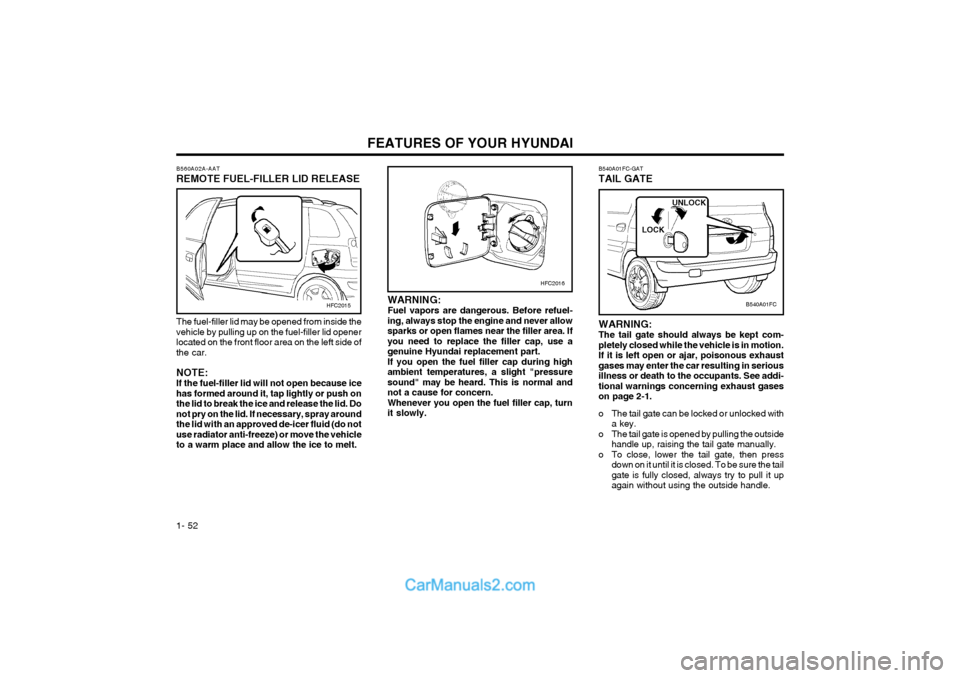
FEATURES OF YOUR HYUNDAI
1- 52
HFC2016
WARNING: Fuel vapors are dangerous. Before refuel-ing, always stop the engine and never allowsparks or open flames near the filler area. Ifyou need to replace the filler cap, use agenuine Hyundai replacement part.If you open the fuel filler cap during highambient temperatures, a slight "pressuresound" may be heard. This is normal andnot a cause for concern.Whenever you open the fuel filler cap, turn
it slowly.
B560A02A-AAT REMOTE FUEL-FILLER LID RELEASE
The fuel-filler lid may be opened from inside the vehicle by pulling up on the fuel-filler lid openerlocated on the front floor area on the left side ofthe car. NOTE: If the fuel-filler lid will not open because icehas formed around it, tap lightly or push onthe lid to break the ice and release the lid. Donot pry on the lid. If necessary, spray aroundthe lid with an approved de-icer fluid (do notuse radiator anti-freeze) or move the vehicleto a warm place and allow the ice to melt.
HFC2015
B540A01FC-GAT TAIL GATE
B540A01FC
WARNING: The tail gate should always be kept com-pletely closed while the vehicle is in motion.If it is left open or ajar, poisonous exhaustgases may enter the car resulting in seriousillness or death to the occupants. See addi-tional warnings concerning exhaust gaseson page 2-1.
o The tail gate can be locked or unlocked with a key.
o The tail gate is opened by pulling the outside handle up, raising the tail gate manually.
o To close, lower the tail gate, then press down on it until it is closed. To be sure the tail gate is fully closed, always try to pull it upagain without using the outside handle. LOCK
UNLOCK
Page 62 of 317
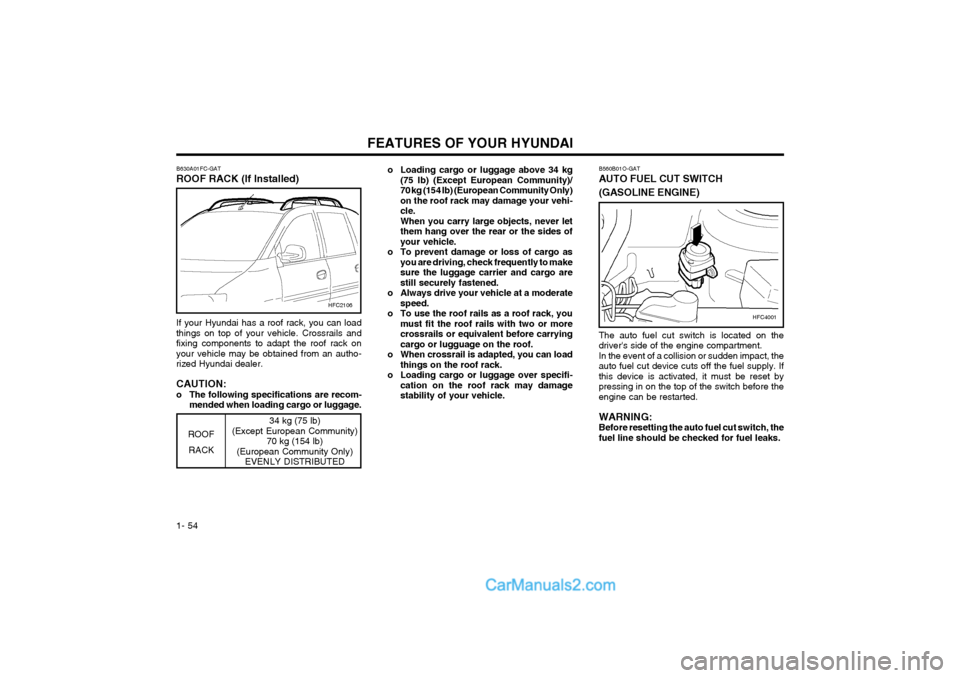
FEATURES OF YOUR HYUNDAI
1- 54 B560B01O-GAT AUTO FUEL CUT SWITCH (GASOLINE ENGINE)
HFC4001
The auto fuel cut switch is located on the driver's side of the engine compartment.In the event of a collision or sudden impact, theauto fuel cut device cuts off the fuel supply. Ifthis device is activated, it must be reset bypressing in on the top of the switch before theengine can be restarted. WARNING: Before resetting the auto fuel cut switch, thefuel line should be checked for fuel leaks.
34 kg (75 lb)
(Except European Community) 70 kg (154 lb)
(European Community Only) EVENLY DISTRIBUTED
HFC2106
B630A01FC-GAT ROOF RACK (If Installed) If your Hyundai has a roof rack, you can load things on top of your vehicle. Crossrails andfixing components to adapt the roof rack onyour vehicle may be obtained from an autho-rized Hyundai dealer. CAUTION:
o The following specifications are recom-
mended when loading cargo or luggage.
ROOF RACK
o Loading cargo or luggage above 34 kg (75 lb) (Except European Community)/
70 kg (154 lb) (European Community Only)on the roof rack may damage your vehi-cle.When you carry large objects, never letthem hang over the rear or the sides ofyour vehicle.
o To prevent damage or loss of cargo as you are driving, check frequently to makesure the luggage carrier and cargo arestill securely fastened.
o Always drive your vehicle at a moderate speed.
o To use the roof rails as a roof rack, you must fit the roof rails with two or morecrossrails or equivalent before carryingcargo or lugguage on the roof.
o When crossrail is adapted, you can load things on the roof rack.
o Loading cargo or luggage over specifi- cation on the roof rack may damagestability of your vehicle.
Page 70 of 317
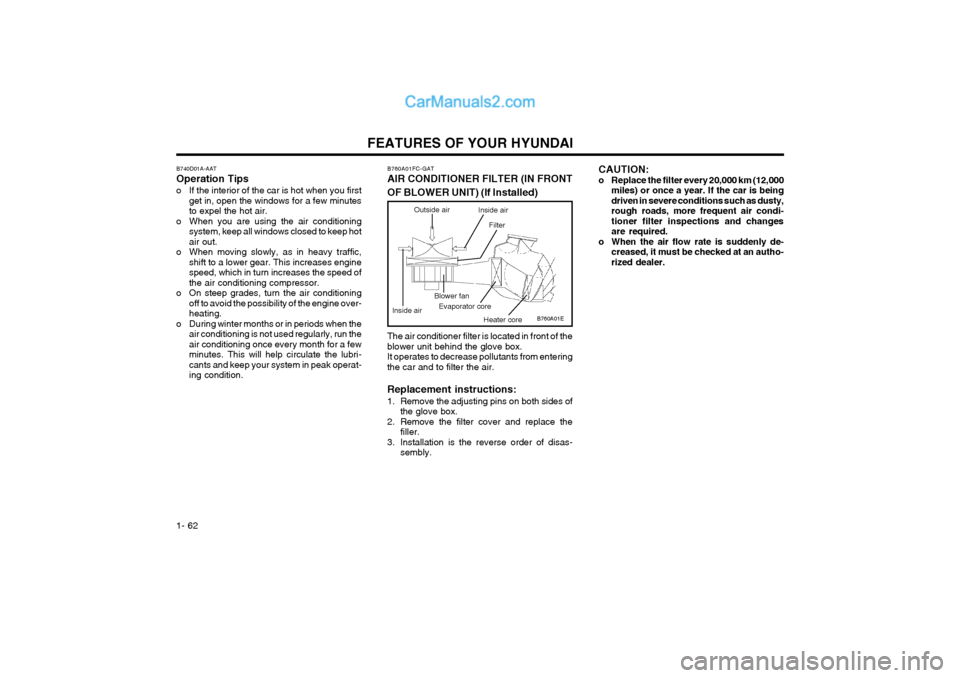
FEATURES OF YOUR HYUNDAI
1- 62
B760A01E
The air conditioner filter is located in front of the blower unit behind the glove box.It operates to decrease pollutants from enteringthe car and to filter the air. Replacement instructions:
1. Remove the adjusting pins on both sides of the glove box.
2. Remove the filter cover and replace the filler.
3. Installation is the reverse order of disas- sembly.
Evaporator coreBlower fan
Heater core
B760A01FC-GAT AIR CONDITIONER FILTER (IN FRONT OF BLOWER UNIT) (If Installed)
Outside air
Filter
Inside air
Inside air CAUTION:
o Replace the filter every 20,000 km (12,000
miles) or once a year. If the car is beingdriven in severe conditions such as dusty,rough roads, more frequent air condi-tioner filter inspections and changesare required.
o When the air flow rate is suddenly de- creased, it must be checked at an autho-rized dealer.
B740D01A-AAT Operation Tips
o If the interior of the car is hot when you firstget in, open the windows for a few minutes to expel the hot air.
o When you are using the air conditioning system, keep all windows closed to keep hotair out.
o When moving slowly, as in heavy traffic, shift to a lower gear. This increases enginespeed, which in turn increases the speed ofthe air conditioning compressor.
o On steep grades, turn the air conditioning off to avoid the possibility of the engine over-heating.
o During winter months or in periods when the air conditioning is not used regularly, run theair conditioning once every month for a fewminutes. This will help circulate the lubri-cants and keep your system in peak operat-ing condition.
Page 71 of 317
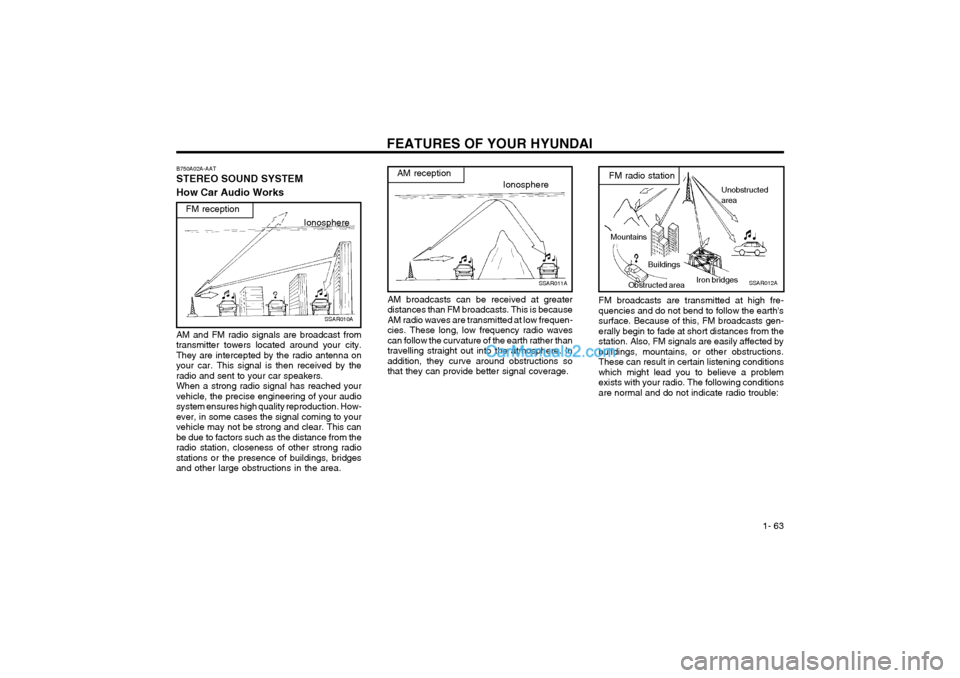
FEATURES OF YOUR HYUNDAI 1- 63
FM broadcasts are transmitted at high fre- quencies and do not bend to follow the earth'ssurface. Because of this, FM broadcasts gen-erally begin to fade at short distances from thestation. Also, FM signals are easily affected bybuildings, mountains, or other obstructions.These can result in certain listening conditionswhich might lead you to believe a problemexists with your radio. The following conditionsare normal and do not indicate radio trouble:
Buildings
Obstructed area Iron bridges
Unobstructed area
FM radio station
SSAR012A
Mountains
Ionosphere
SSAR011A
AM reception
AM broadcasts can be received at greater distances than FM broadcasts. This is becauseAM radio waves are transmitted at low frequen-cies. These long, low frequency radio wavescan follow the curvature of the earth rather thantravelling straight out into the atmosphere. Inaddition, they curve around obstructions sothat they can provide better signal coverage.
B750A02A-AAT STEREO SOUND SYSTEM How Car Audio Works
Ionosphere
FM reception
SSAR010A
AM and FM radio signals are broadcast from transmitter towers located around your city.They are intercepted by the radio antenna onyour car. This signal is then received by theradio and sent to your car speakers.When a strong radio signal has reached yourvehicle, the precise engineering of your audiosystem ensures high quality reproduction. How-ever, in some cases the signal coming to yourvehicle may not be strong and clear. This canbe due to factors such as the distance from theradio station, closeness of other strong radiostations or the presence of buildings, bridgesand other large obstructions in the area.
Page 99 of 317
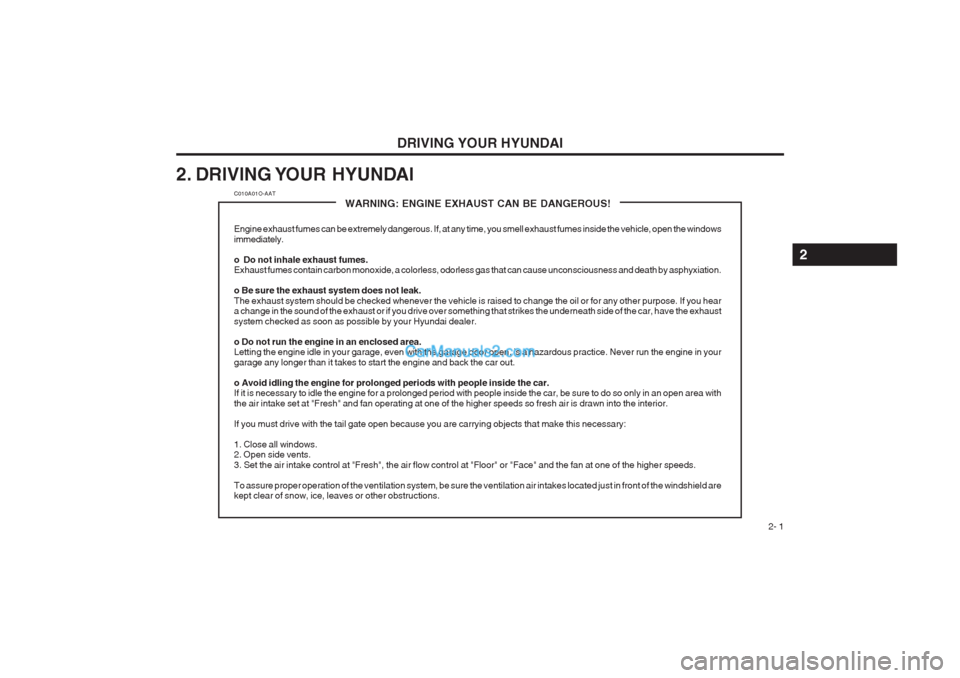
DRIVING YOUR HYUNDAI 2- 1
2. DRIVING YOUR HYUNDAI
C010A01O-AAT
WARNING: ENGINE EXHAUST CAN BE DANGEROUS!
Engine exhaust fumes can be extremely dangerous. If, at any time, you smell exhaust fumes inside the vehicle, open the windows immediately. o Do not inhale exhaust fumes. Exhaust fumes contain carbon monoxide, a colorless, odorless gas that can cause unconsciousness and death by asphyxiation. o Be sure the exhaust system does not leak. The exhaust system should be checked whenever the vehicle is raised to change the oil or for any other purpose. If you hear a change in the sound of the exhaust or if you drive over something that strikes the underneath side of the car, have the exhau st
system checked as soon as possible by your Hyundai dealer. o Do not run the engine in an enclosed area. Letting the engine idle in your garage, even with the garage door open, is a hazardous practice. Never run the engine in your garage any longer than it takes to start the engine and back the car out. o Avoid idling the engine for prolonged periods with people inside the car. If it is necessary to idle the engine for a prolonged period with people inside the car, be sure to do so only in an open area with
the air intake set at "Fresh" and fan operating at one of the higher speeds so fresh air is drawn into the interior. If you must drive with the tail gate open because you are carrying objects that make this necessary:1. Close all windows. 2. Open side vents. 3. Set the air intake control at "Fresh", the air flow control at "Floor" or "Face" and the fan at one of the higher speeds.
To assure proper operation of the ventilation system, be sure the ventilation air intakes located just in front of the windshield are kept clear of snow, ice, leaves or other obstructions.
2
Page 100 of 317
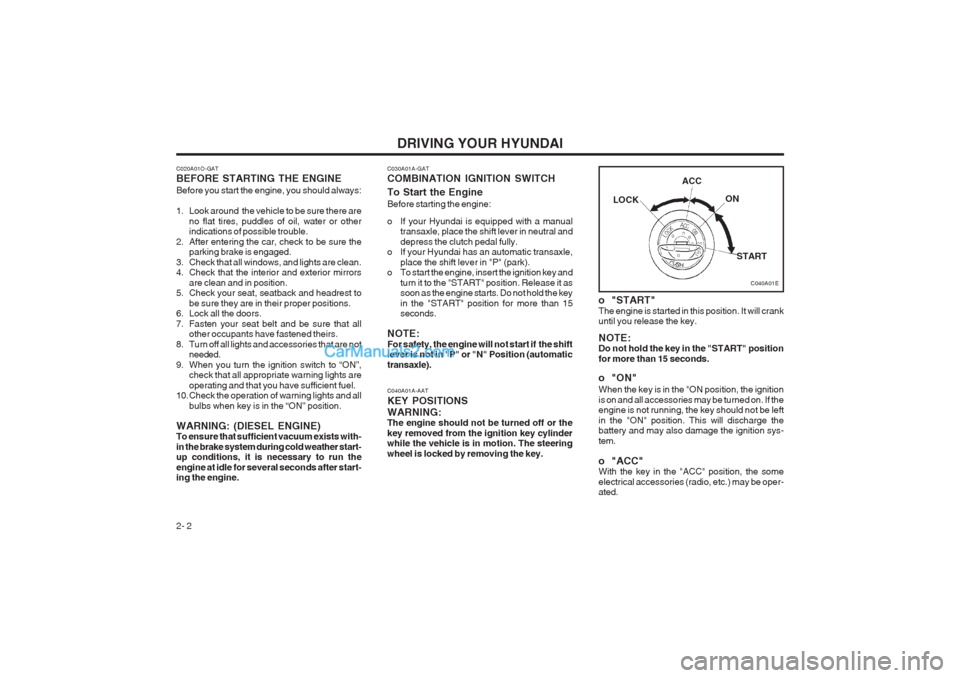
DRIVING YOUR HYUNDAI
2- 2
C040A01A-AAT KEY POSITIONSWARNING: The engine should not be turned off or the key removed from the ignition key cylinder while the vehicle is in motion. The steering wheel is locked by removing the key.
C040A01E
LOCK
ACC
ON
START
o "START" The engine is started in this position. It will crank until you release the key. NOTE: Do not hold the key in the "START" position for more than 15 seconds.
o "ON" When the key is in the "ON position, the ignition is on and all accessories may be turned on. If the engine is not running, the key should not be left in the "ON" position. This will discharge the battery and may also damage the ignition sys- tem.
o "ACC" With the key in the "ACC" position, the some electrical accessories (radio, etc.) may be oper- ated.
C020A01O-GAT BEFORE STARTING THE ENGINE Before you start the engine, you should always:
1. Look around the vehicle to be sure there are
no flat tires, puddles of oil, water or other indications of possible trouble.
2. After entering the car, check to be sure the parking brake is engaged.
3. Check that all windows, and lights are clean.
4. Check that the interior and exterior mirrors are clean and in position.
5. Check your seat, seatback and headrest to
be sure they are in their proper positions.
6. Lock all the doors.
7. Fasten your seat belt and be sure that all other occupants have fastened theirs.
8. Turn off all lights and accessories that are not needed.
9. When you turn the ignition switch to “ON”, check that all appropriate warning lights areoperating and that you have sufficient fuel.
10. Check the operation of warning lights and all
bulbs when key is in the “ON” position.
WARNING: (DIESEL ENGINE) To ensure that sufficient vacuum exists with- in the brake system during cold weather start- up conditions, it is necessary to run the engine at idle for several seconds after start- ing the engine.
C030A01A-GAT COMBINATION IGNITION SWITCH To Start the Engine Before starting the engine:
o If your Hyundai is equipped with a manual transaxle, place the shift lever in neutral and depress the clutch pedal fully.
o If your Hyundai has an automatic transaxle,
place the shift lever in "P" (park).
o To start the engine, insert the ignition key and
turn it to the "START" position. Release it as soon as the engine starts. Do not hold the key in the "START" position for more than 15 seconds.
NOTE: For safety, the engine will not start if the shift lever is not in "P" or "N" Position (automatic transaxle).
Page 101 of 317
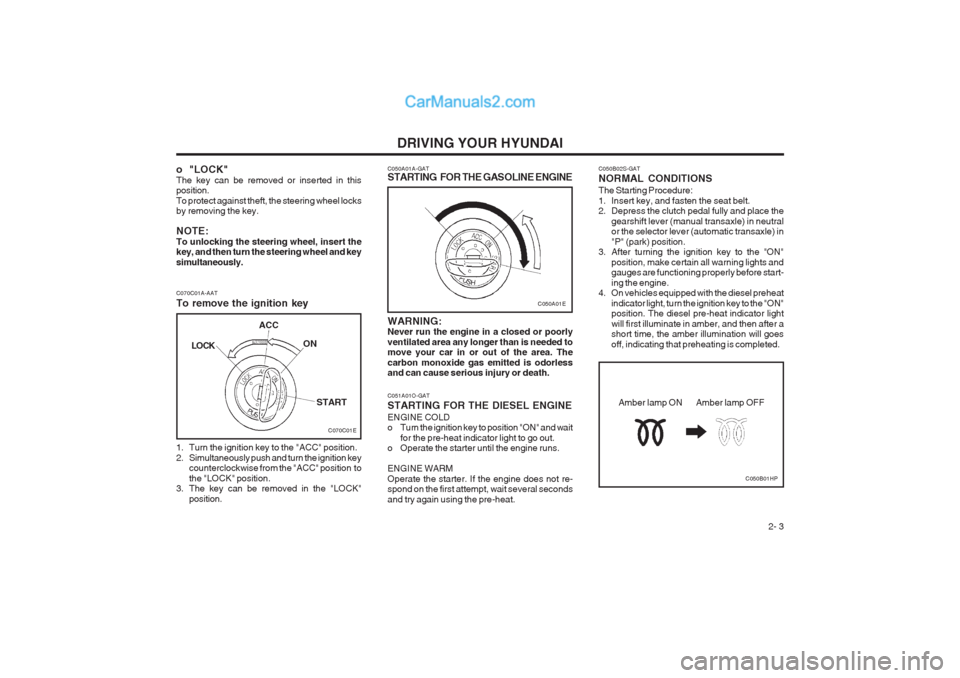
DRIVING YOUR HYUNDAI 2- 3
C070C01E
C070C01A-AAT To remove the ignition key
1. Turn the ignition key to the "ACC" position.
2. Simultaneously push and turn the ignition key
counterclockwise from the "ACC" position tothe "LOCK" position.
3. The key can be removed in the "LOCK"
position.LOCK
ACC
ON
START
C050A01E
C050A01A-GAT
STARTING FOR THE GASOLINE ENGINE WARNING: Never run the engine in a closed or poorly ventilated area any longer than is needed to move your car in or out of the area. The carbon monoxide gas emitted is odorless and can cause serious injury or death. C051A01O-GAT STARTING FOR THE DIESEL ENGINE ENGINE COLD
o Turn the ignition key to position "ON" and wait
for the pre-heat indicator light to go out.
o Operate the starter until the engine runs. ENGINE WARM Operate the starter. If the engine does not re- spond on the first attempt, wait several seconds and try again using the pre-heat.
o "LOCK" The key can be removed or inserted in this position. To protect against theft, the steering wheel locks by removing the key. NOTE: To unlocking the steering wheel, insert the key, and then turn the steering wheel and key simultaneously. C050B02S-GAT NORMAL CONDITIONS The Starting Procedure:
1. Insert key, and fasten the seat belt.
2. Depress the clutch pedal fully and place the
gearshift lever (manual transaxle) in neutralor the selector lever (automatic transaxle) in "P" (park) position.
3. After turning the ignition key to the "ON"
position, make certain all warning lights and gauges are functioning properly before start- ing the engine.
4. On vehicles equipped with the diesel preheat
indicator light, turn the ignition key to the "ON" position. The diesel pre-heat indicator light will first illuminate in amber, and then after a short time, the amber illumination will goes off, indicating that preheating is completed.
C050B01HP
Amber lamp ON Amber lamp OFF
Page 102 of 317
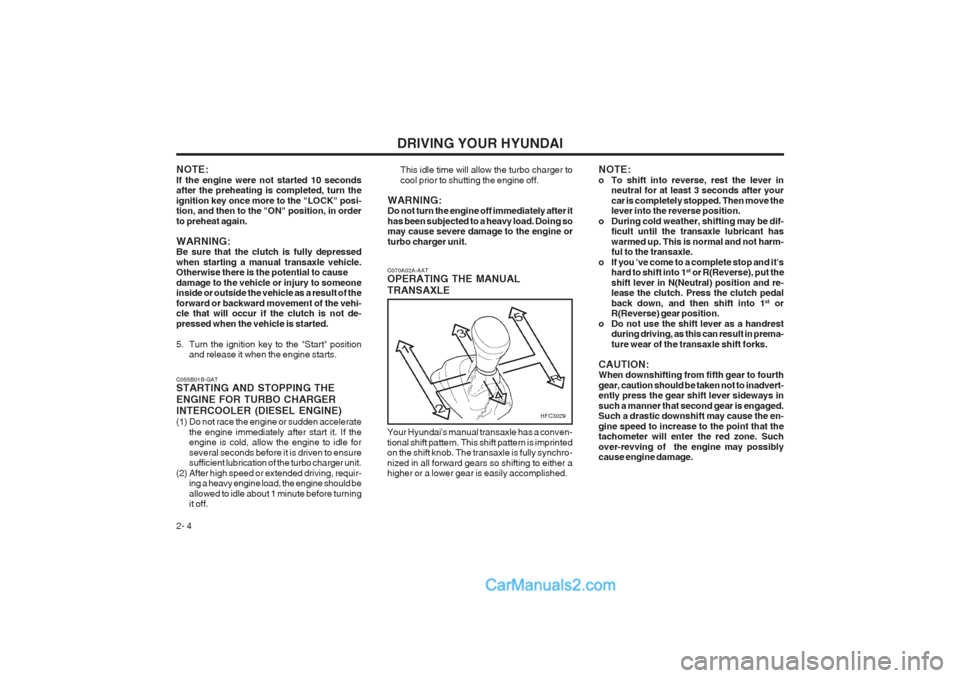
DRIVING YOUR HYUNDAI
2- 4 C070A02A-AAT OPERATING THE MANUAL TRANSAXLE
HFC3029
Your Hyundai's manual transaxle has a conven- tional shift pattern. This shift pattern is imprinted on the shift knob. The transaxle is fully synchro- nized in all forward gears so shifting to either a higher or a lower gear is easily accomplished.
C055B01B-GAT STARTING AND STOPPING THE ENGINE FOR TURBO CHARGER INTERCOOLER (DIESEL ENGINE)
(1) Do not race the engine or sudden accelerate
the engine immediately after start it. If the engine is cold, allow the engine to idle for several seconds before it is driven to ensure sufficient lubrication of the turbo charger unit.
(2) After high speed or extended driving, requir- ing a heavy engine load, the engine should be allowed to idle about 1 minute before turning it off.
NOTE: If the engine were not started 10 seconds after the preheating is completed, turn the ignition key once more to the "LOCK" posi- tion, and then to the "ON" position, in order to preheat again. WARNING: Be sure that the clutch is fully depressed when starting a manual transaxle vehicle. Otherwise there is the potential to cause damage to the vehicle or injury to someone inside or outside the vehicle as a result of the forward or backward movement of the vehi- cle that will occur if the clutch is not de- pressed when the vehicle is started.
5. Turn the ignition key to the "Start" position
and release it when the engine starts. This idle time will allow the turbo charger to cool prior to shutting the engine off.
WARNING: Do not turn the engine off immediately after it has been subjected to a heavy load. Doing so may cause severe damage to the engine or turbo charger unit. NOTE:
o To shift into reverse, rest the lever in
neutral for at least 3 seconds after yourcar is completely stopped. Then move the lever into the reverse position.
o During cold weather, shifting may be dif- ficult until the transaxle lubricant has warmed up. This is normal and not harm- ful to the transaxle.
o If you 've come to a complete stop and it's hard to shift into 1 st
or R(Reverse), put the
shift lever in N(Neutral) position and re-lease the clutch. Press the clutch pedal back down, and then shift into 1 st
or
R(Reverse) gear position.
o Do not use the shift lever as a handrest during driving, as this can result in prema-ture wear of the transaxle shift forks.
CAUTION: When downshifting from fifth gear to fourth gear, caution should be taken not to inadvert- ently press the gear shift lever sideways in such a manner that second gear is engaged. Such a drastic downshift may cause the en- gine speed to increase to the point that the tachometer will enter the red zone. Such over-revving of the engine may possibly cause engine damage.
Page 103 of 317
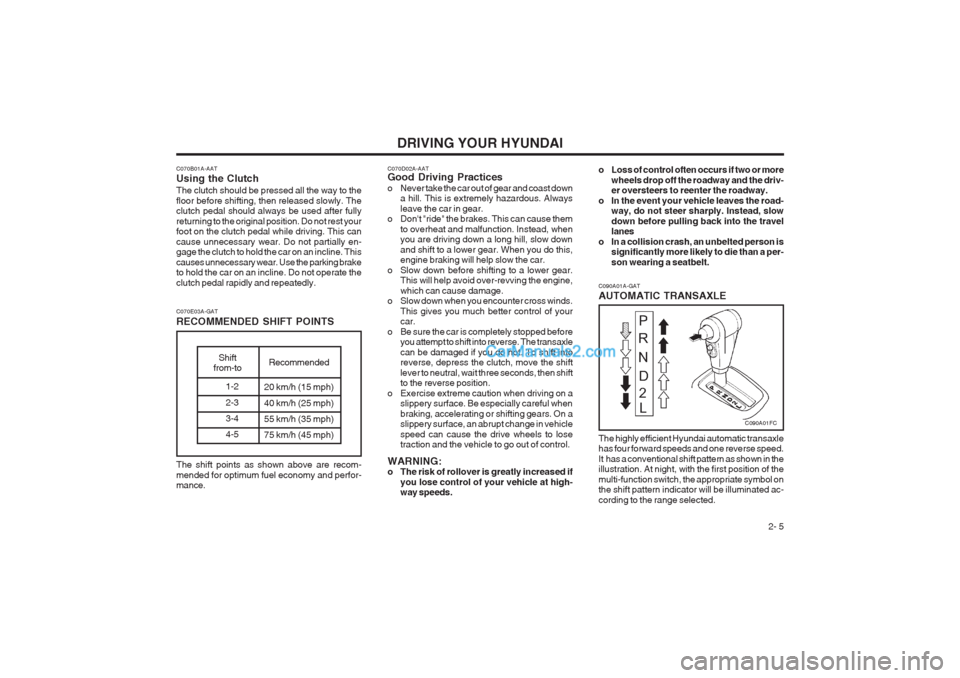
DRIVING YOUR HYUNDAI 2- 5
C070B01A-AAT Using the Clutch The clutch should be pressed all the way to the floor before shifting, then released slowly. The clutch pedal should always be used after fully returning to the original position. Do not rest your foot on the clutch pedal while driving. This can cause unnecessary wear. Do not partially en- gage the clutch to hold the car on an incline. This causes unnecessary wear. Use the parking brake to hold the car on an incline. Do not operate the clutch pedal rapidly and repeatedly. C070E03A-GAT RECOMMENDED SHIFT POINTS
1-2 2-3 3-44-5
Shift
from-to Recommended
20 km/h (15 mph) 40 km/h (25 mph) 55 km/h (35 mph)75 km/h (45 mph)
The shift points as shown above are recom- mended for optimum fuel economy and perfor- mance. C070D02A-AAT Good Driving Practices
o Never take the car out of gear and coast down
a hill. This is extremely hazardous. Always leave the car in gear.
o Don't "ride" the brakes. This can cause them
to overheat and malfunction. Instead, when you are driving down a long hill, slow down and shift to a lower gear. When you do this, engine braking will help slow the car.
o Slow down before shifting to a lower gear. This will help avoid over-revving the engine, which can cause damage.
o Slow down when you encounter cross winds.
This gives you much better control of your car.
o Be sure the car is completely stopped before you attempt to shift into reverse. The transaxle can be damaged if you do not. To shift into reverse, depress the clutch, move the shift lever to neutral, wait three seconds, then shift to the reverse position.
o Exercise extreme caution when driving on a slippery surface. Be especially careful when braking, accelerating or shifting gears. On a slippery surface, an abrupt change in vehicle speed can cause the drive wheels to lose traction and the vehicle to go out of control.
WARNING:
o The risk of rollover is greatly increased if you lose control of your vehicle at high-way speeds. C090A01A-GAT AUTOMATIC TRANSAXLE
C090A01FC
The highly efficient Hyundai automatic transaxle has four forward speeds and one reverse speed. It has a conventional shift pattern as shown in the illustration. At night, with the first position of the multi-function switch, the appropriate symbol on the shift pattern indicator will be illuminated ac- cording to the range selected.
o Loss of control often occurs if two or more
wheels drop off the roadway and the driv- er oversteers to reenter the roadway.
o In the event your vehicle leaves the road- way, do not steer sharply. Instead, slow down before pulling back into the travel lanes
o In a collision crash, an unbelted person is significantly more likely to die than a per- son wearing a seatbelt.